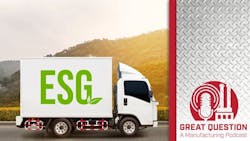Podcast: How Logistics Companies are Helping Plants Calculate Their Carbon Cost
Companies around the globe are working hard to establish new systems for documenting and reporting their greenhouse gas footprints, and other data relating to their products and supply chains. To achieve this and stay in compliance with ESG standards, plants are leaning more than ever on their logistics partners to provide key data on supply chain-related carbon emissions.
In this bonus podcast, Plant Services chief editor Thomas Wilk continues his conversation with Jason Manganaro, VP of Commercial Technology for the Americas at SPARX Logistics, on the current capabilities of logistics to calculate and provide these carbon data.
Below is an excerpt from the podcast:
TW: Are you and your team being asked by customers to help comply with certain ESG regulations, or at least calculate the carbon footprint and then the carbon cost of moving things around the globe? That's something which we're hearing more and more that plant managers are being asked to understand, which is what is the carbon cost of getting materials to the plant. So I was curious to know, is a company like SPARX being asked to help calculate that stuff to or at least keep track of it?
JM: Yeah, that's a great question and it's become a really hot topic. I would say, just to kind of level set, I feel like there's probably three categories of companies out there on this. There's a category that is and has always been concerned about environmental issues. It's either the ethos of the company itself, their customers, they know the customers that buy their product care about this and therefore they care about it, or you know they're in an industry where it's really highlighted this need to really be responsible about your impact is. It’s just part of the playing field, right? So there's definitely a set of very motivated companies that have been studying this and been looking for solutions on this, and we've had some really good conversations with companies in that category.
There's a second set that I would say is concerned about it. They want to see what's going to happen next. They're closely watching, for example, the ETS, the emissions trading system that Europe is going to be rolling out, I think it's from 2024 to 2026, to push the market to regulate itself in terms of scaling down carbon emissions, and having a cost involved for companies that are not scaling them down or not keeping them under control. And then there's of course that kind of longer term Paris agreement, reduce emissions by I think it's 45% by 2030 and then to net zero by 2050, and that's kind of a global initiative that's going on. So there's a lot of companies out there I think that are paying attention to all this. Those dates are pretty far down the line if you're a kind of quarter-to-quarter operating company, so they're not necessarily jumping in with both feet right now, but they want to know what's happening. They want to know what the potential exposure to them will be. They want to know what the penalties might be if they're slow in adhering to this.
And then there's a third set that are just blocking their ears, what our kids do when they don't want to hear bad news about something. Those companies are probably going to wait until it is absolutely the last necessity to adhere to any of this stuff, and I understand it, from a business standpoint they just see it as cost and complication and so forth.
We're really focused on that first set that already care about it and are already putting some energy into it because. One of the biggest concerns I think we hear from the industry is that they understand that this coming, they want to be responsible. They want to be able to measure what their emissions and their carbon impact is, but they don't feel like they have the tools to do it. You mentioned that there's some tools in the production side that you can apply; on the supply chain side, they're really reliant on other parties to give them those numbers. And what I hear over and over again is, “listen, I've got three carriers moving on the same lanes and I’ve got three completely different outputs of what they measure the carbon footprint as. And when I dig into it, I don't really trust any of the three of them, because I don't see the math behind it.”
This isn't to point blame or anything. I feel like carriers are being put in an unfortunate position too here where they're being asked to measure something that they've never really measured this closely before and account for. Where we're at now is the stage of, you know, an average of an approximation of a guesstimate of whatever number they can kind of come up with and say, “OK, this going to be our base, and we're just going to replicate this and see where we are.”
Thomas Wilk | Editor-in-Chief
Thomas Wilk joined Plant Services as editor-in-chief in 2014. Previously, Wilk was content strategist / mobile media manager at Panduit. Prior to Panduit, Tom was lead editor for Battelle Memorial Institute's Environmental Restoration team, and taught business and technical writing at Ohio State University for eight years. Tom holds a BA from the University of Illinois and an MA from Ohio State University
About the Author
Tom Wilk
Editor in Chief, Plant Services – Endeavor Business Media
Tom Wilk is the Editor in Chief of Plant Services, an Endeavor Business Media partner site.
Previously, Tom was a Technical Writer and a Social Media Manager for Panduit as well as a Senior Technical Editor for Battelle Memorial Institute.

